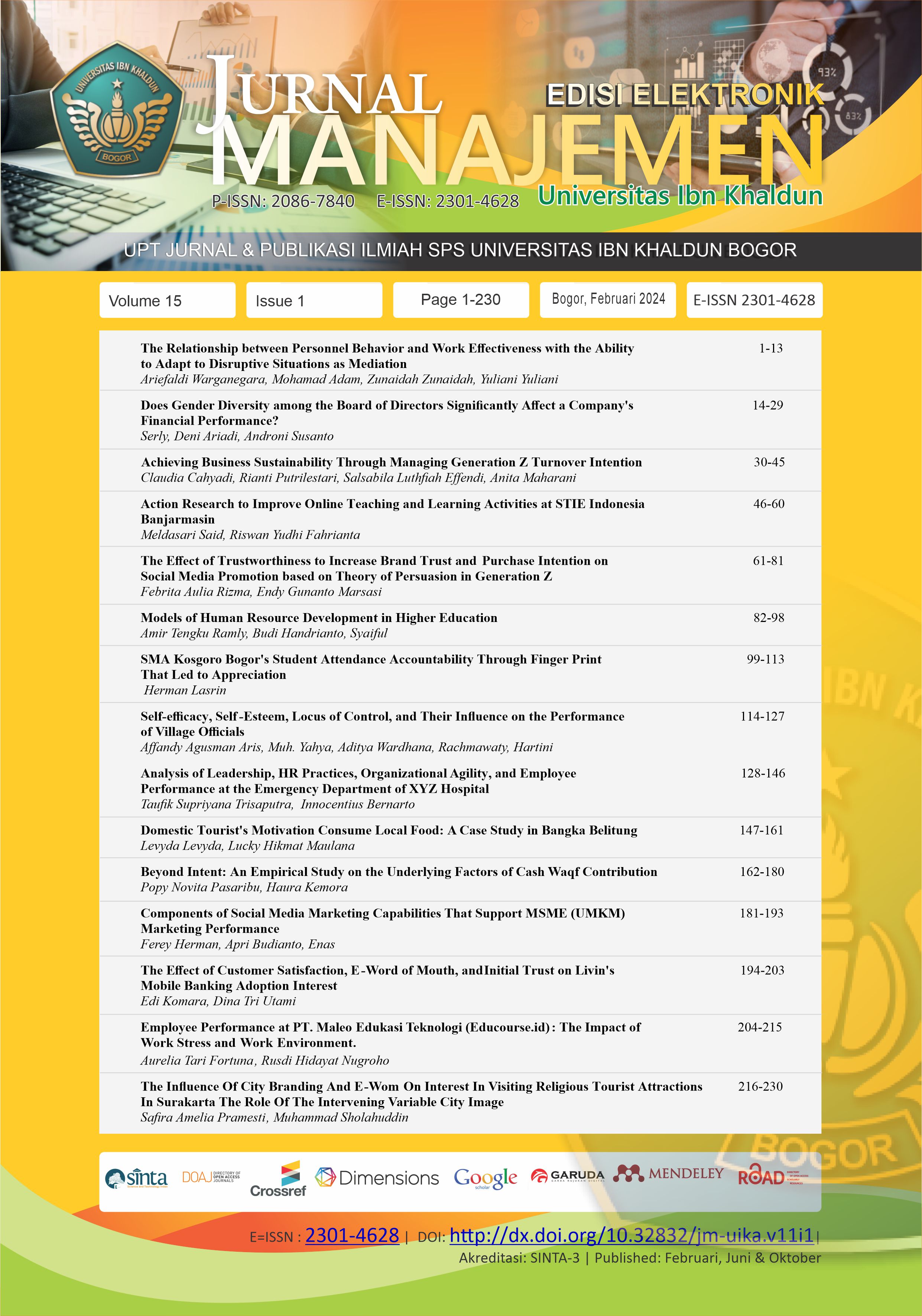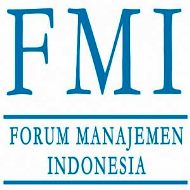Analysis of Leadership, HR Practices, Organizational Agility, and Employee Performance at the Emergency Department of XYZ Hospital
DOI:
https://doi.org/10.32832/jm-uika.v15i1.15088Abstrak
The Emergency Department (ED) is a complex unit with a dynamic environment characterized by rapid changes, high uncertainty, and many unforeseen possibilities. Therefore, hospitals need to implement appropriate Leadership and HR Practices to achieve Organizational Agility in the ED and improve employee performance to provide the best service to patients. This study aims to analyze Leadership, HR Practices, Organizational Agility, and Employee Performance in the ED unit of Seto Hasbadi Bekasi Hospital. The sampling technique used was a census with a sample size of 65 healthcare workers. The data analysis technique used in this study was Partial Least Square - Structural Equation Modeling (PLS-SEM) with SmartPLS software. The results showed that Leadership had a significant positive effect on HR Practices, but did not affect Organizational Agility and Employee Performance. HR Practices had a significant positive effect on Organizational Agility. HR Practices also had a significant positive effect on Employee Performance. Furthermore, Organizational Agility had a significant positive effect on Employee Performance. The management of Seto Hasbadi Bekasi Hospital has implemented good HR Practices, which has had a positive impact on the performance of healthcare workers in the ED. The maximum implementation of HR Practices will make the hospital agile, effective, and efficient in handling all conditions in the ED.
Referensi
Abugre, J. B., & Nasere, D. (2020). Do high-performance work systems mediate the relationship between HR practices and employee performance in multinational corporations (MNCs) in developing economies? African Journal of Economic and Management Studies, 11(4), 541–557. https://doi.org/10.1108/AJEMS-01-2019-0028
Akkaya, B., & Mert, G. (2022). Organizational agility, competitive capabilities, and the performance of health care organizations during the covid-19 pandemic. Central European Management Journal, 30(2), 2–25. https://doi.org/10.7206/cemj.2658-0845.73
Ananthram, S., & Nankervis, A. (2013). Strategic agility and the role of HR as a strategic business partner: An Indian perspective. Asia Pacific Journal of Human Resources, 51(4), 454–470. https://doi.org/10.1111/1744-7941.12004
Bouaziz, F., & Smaoui Hachicha, Z. (2018). Strategic human resource management practices and organizational resilience. Journal of Management Development, 37(7), 537–551. https://doi.org/10.1108/JMD-11-2017-0358
Budiastuti, D., & Bandur, A. (2018). Validitas dan reliabilitas penelitian. Mitra Wacana Media. www.mitrawacanamedia.com
Buil, I., Martínez, E., & Matute, J. (2019). Transformational leadership and employee performance: The role of identification, engagement and proactive personality. International Journal of Hospitality Management, 77, 64–75. https://doi.org/https://doi.org/10.1016/j.ijhm.2018.06.014
Dorgham, S. R., & Al-Mahmoud, S. A. (2013). Leadership styles and clinical decision making autonomy among critical care nurses: A comparative study. IOSR Journal of Nursing and Health Science, 1(4), 71–83.
Falola, H. O., Osibanjo, A. O., & Ojo, I. S. (2014). Effectiveness of training and development on employees’ performance and organisation competitiveness in the nigerian banking industry. Economic Sciences, 7(56), 1–16.
Ghazali, P. L., Mazlina, A. N., Izah, M. T., Maslina, M., Zulqurnaim, W. I., & Mustafa, M. (2015). Optimization of integration model in family takaful. Applied Mathematical Sciences, 9(39), 1899–1909.
Goldman, S. L., Nagel, R. N., & Preiss, K. (1995). Agile competitors and virtual organizations. Manufacturing review, 8(1), 59–67.
Goodarzi, B., Shakeri, K., Ghaniyoun, A., & Heidari, M. (2018). Assessment correlation of the organizational agility of human resources with the performance staff of Tehran Emergency Center. Journal of Education and Health Promotion, 7, 142. https://doi.org/10.4103/jehp.jehp_109_18
Hair, J. F., Hult, G. T. M., Ringle, C. M., & Sarstedt, M. (2017). A primer on partial least squares structural equation modeling (PLS-SEM) (2 ed.). Sage publications.
James, O. E., Ella, R., SE, N., Lukpata, F. E., Uwa, S. L., & Mbum, P. A. (2015). Effect of reward system among health care workers performance: A case study of University of Calabar Teaching Hospital Calabar, Nigeria. Journal of Hospital Administration, 4(3), 45–53. https://doi.org/10.5430/jha.v4n3p45
Kelidbari, H. R. R., Fadaei, M., & Ebrahimi, P. (2016). The role of ethical leadership on employee performance in Guilan University of Medical Sciences. Procedia - Social and Behavioral Sciences, 230, 463–470. https://doi.org/https://doi.org/10.1016/j.sbspro.2016.09.058
Khalid, Z., Madhakomala, R., & Purwana, D. (2020). How leadership and organizational culture shape organizational agility in Indonesian SMEs?? IJHCM (International Journal of Human Capital Management), 4(2), 49–63. https://doi.org/10.21009/IJHCM.04.02.06
Kinicki, A., & Fugate, M. (2016). Organizational behavior: A practical, problem-solving approach (2 ed., Vol. 2). McGraw-Hill Education.
Knies, E., Leisink, P., & Kraus-Hoogeveen, S. (2018). Frontline managers’ contribution to mission achievement: A study of how people management affects thoughtful care. Human Service Organizations: Management, Leadership & Governance, 42(2), 166–184. https://doi.org/10.1080/23303131.2017.1422067
Kooij, D. T. A. M., Guest, D. E., Clinton, M., Knight, T., Jansen, P. G. W., & Dikkers, J. S. E. (2013). How the impact of HR practices on employee well-being and performance changes with age. Human Resource Management Journal, 23(1), 18–35. https://doi.org/10.1111/1748-8583.12000
Lee, D. H., Hong, K. S., & Kim, N. Y. (2016). Effects of hospital leadership, organizational systems, and ESWOS on medical error reduction. Service Business, 10(1), 159–177. https://doi.org/10.1007/s11628-014-0262-x
Martin, J., Mccormack, B., Fitzsimons, D., & Spirig, R. (2014). The importance of inspiring a shared vision. International Practice Development Journal, 4(2), 1–15.
McShane, S. L., & Von Glinow, M. A. (2018). Organizational behavior: Emerging knowledge. Global reality (8 ed.). McGraw Hill Education.
Melián-Alzola, L., Domínguez-Falcón, C., & Martín-Santana, J. D. (2020). The role of the human dimension in organizational agility: An empirical study in intensive care units. Personnel Review, 49(9), 1945–1964. https://doi.org/10.1108/PR-08-2019-0456
Menon, S., & Suresh, M. (2021). Factors influencing organizational agility in higher education. Benchmarking: An International Journal, 28(1), 307–332. https://doi.org/10.1108/BIJ-04-2020-0151
Mohd Nasurdin, A., Tan, C. L., & Naseer Khan, S. (2020). Can high performance work practices and satisfaction predict job performance? An examination of the Malaysian private health-care sector. International Journal of Quality and Service Sciences, 12(4), 521–540. https://doi.org/10.1108/IJQSS-06-2019-0090
Mooghali, A., Ghorbani, E., & Emami, M. (2016). The impact of HRM practices on agility of Kosar hospital staff in Shiraz. International Journal of Humanities and Cultural Studies, 16, 2442–2457.
Nafei, W. A. (2016). Organizational agility : The key to organizational success. 11(5), 296–309. https://doi.org/10.5539/ijbm.v11n5p296
Novitasari, D., Goestjahjanti, F. S., & Asbari, M. (2020). The Role of Readiness to Change between Transformational Leadership and Performance: Evidence from a Hospital during Covid-19 Pandemic. APMBA (Asia Pacific Management and Business Application), 9(1), 37–56.
Osibanjo, O., Adeniji, A., Falola, H., & Heirsmac, P. (2014). Compensation packages: A strategic tool for employees’ performance and retention. Leonardo Journal of Sciences, 13(25), 65–84.
Rubel, M. R. B., Hung Kee, D. M., & Rimi, N. N. (2021). High-performance work practices and medical professionals’ work outcomes: The mediating effect of perceived organizational support. Journal of Advances in Management Research, 18(3), 368–391. https://doi.org/10.1108/JAMR-05-2020-0076
Sanadgol, M. (2014). The survey of relationship between organizational agility and principals job satisfaction. International Journal of Basic Sciences & Applied Research, 3, 317–319.
Sandahl, C., Gustafsson, H., Wallin, C., Meurling, L., Øvretveit, J., Brommels, M., & Hansson, J. (2013). Simulation team training for improved teamwork in an intensive care unit. International Journal of Health Care Quality Assurance, 26(2), 174–188. https://doi.org/10.1108/09526861311297361
Schumacker, R. E., & Lomax, R. G. (2010). A beginner’s guide to structural equation modeling. In Third Edition (p. 495). Taylor and Francis Group.
Silva, L. J. da, Leite, J. L., Silva, T. P. da, Silva, Í. R., Mourão, P. P., & Gomes, T. M. (2018). Management challenges for best practices of the Kangaroo Method in the Neonatal ICU. Revista Brasileira de Enfermagem (REBEn), 71(6), 2783–2791. https://doi.org/10.1590/0034-7167-2018-0428
Sugiyono. (2019). Metode Peneliotian Kuantitatif, Kualitatif dan R&D. Alfabeta.
Tamer, G. (2021). The effect of visionary leadership characteristics on organizational agility in health organizations; An application in private hospitals in Bakirkoy District of Istanbul Province. İstanbul Gelişim Üniversitesi Sosyal Bilimler Dergisi, 8(2), 240–252. https://doi.org/10.17336/igusbd.655890
Tamtam, F., & Tourabi, A. (2020). Organizational agility assessment of a moroccan healthcare organization in times of COVID-19. Advances in Science, Technology and Engineering Systems,
van der Sluijs, A. F., van Slobbe-Bijlsma, E. R., Chick, S. E., Vroom, M. B., Dongelmans, D. A., & Vlaar, A. P. J. (2017). The impact of changes in intensive care organization on patient outcome and cost-effectiveness—A narrative review. Journal of Intensive Care, 5(1), 1–8. https://doi.org/10.1186/s40560-016-0207-7
Vinodh, S., Aravindraj, S., Pushkar, B., & Kishore, S. (2012). Estimation of reliability and validity of agility constructs using structural equation modelling. International Journal of Production Research, 50(23), 6737–6745. https://doi.org/10.1080/00207543.2011.623246
Worley, C. G., & Lawler, E. E. (2010). Agility and organization design: A diagnostic framework. Organizational Dynamics, 39(2), 194–204.
Unduhan
Diterbitkan
Cara Mengutip
Terbitan
Bagian
Lisensi
Hak Cipta (c) 2024 Jurnal Manajemen (Edisi Elektronik)

Artikel ini berlisensi Creative Commons Attribution-NonCommercial 4.0 International License.
Authors who publish with this journal agree to the following terms:
- Authors retain copyright and grant the journal right of first publication with the work simultaneously licensed under a Creative Commons Attribution-NonCommercial-ShareAlike 4.0 International License that allows others to share the work with an acknowledgement of the work's authorship and initial publication in this journal.
- Authors can enter into separate, additional contractual arrangements for the non-exclusive distribution of the journal's published version of the work (e.g., post it to an institutional repository or publish it in a book), with an acknowledgement of its initial publication in this journal.
- Authors are permitted and encouraged to post their work online (e.g., in institutional repositories or on their website) prior to and during the submission process, as it can lead to productive exchanges, as well as earlier and greater citation of published work (See The Effect of Open Access).











